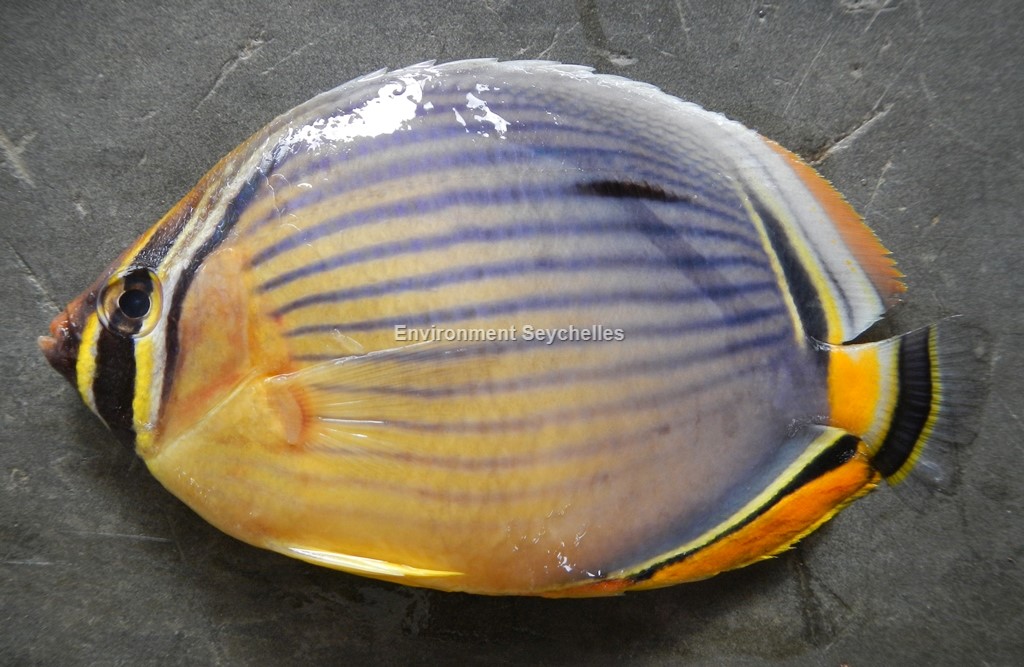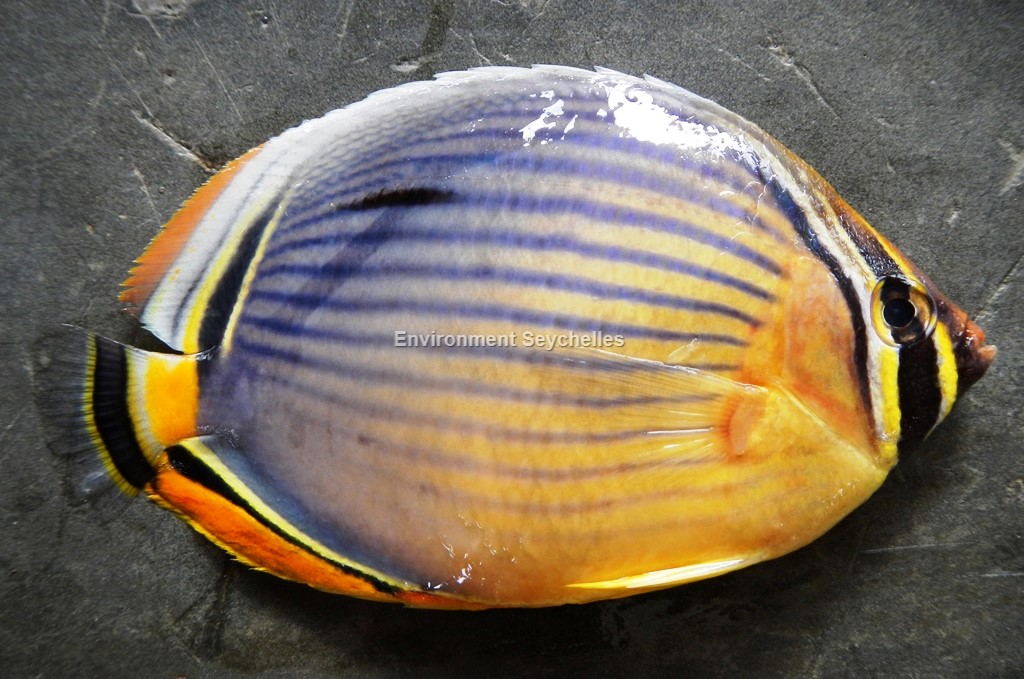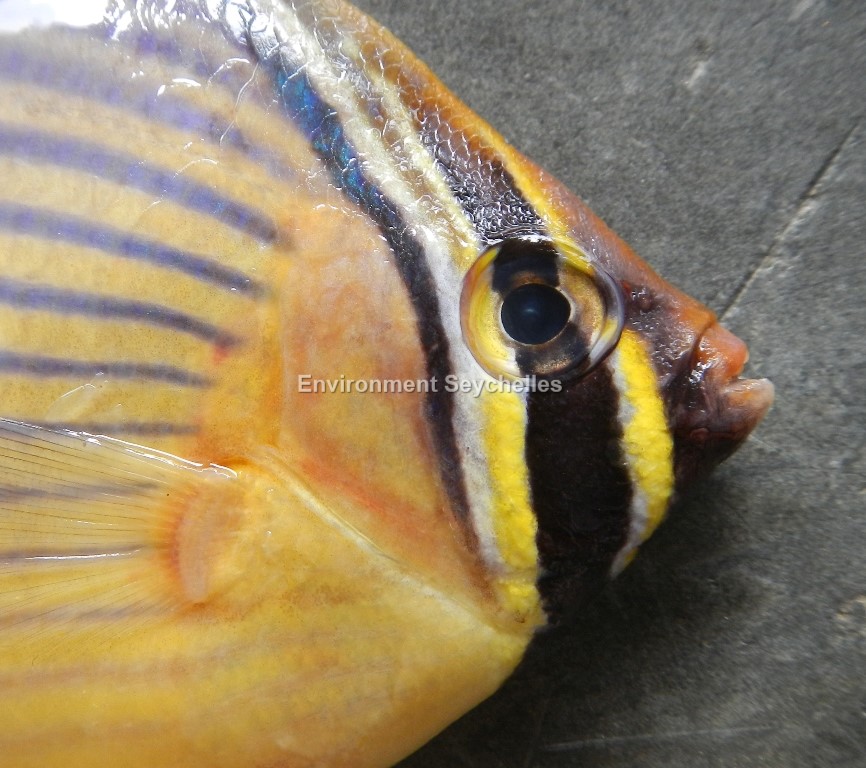Description:
Dorsal spines: 13-14; Dorsal rays: 20-22; Anal spines: 3; Anal rays: 18-21.
Small, oval shaped, laterally compressed fish. Angular snout with terminal mouth.
Colour. A complex colour pattern with many fine details (see photos). In summary, however: base colour pale orange shading to bluish posteriorly. Blue grey stripes run the
length of the body from rear of the opercle, the fifth line down bearing a black streak in its posterior third. A yellow margined black band runs down the head through the
eye to the “throat”. A white and black band runs adjacent to it posteriorly. The snout is black with tip and mouth a brownish orange. The anal, caudal and posterior dorsal
fin bases exhibit a yellow-margined black band. The anal fin has an outer yellow edge. The caudal peduncle is orange and the distal portion of the caudal fin is transparent.
The posterior portion of the dorsal fin exhibits a white band with a narrow black line running though it and a narrow black edge followed by an outer orange margin. Pectoral
fin is transparent. Pelvic fins are pale orange.
Size:
Maturity: Lm unknown. Range Unknown. Max Length: 15cm TL. Commonly to 12cm TL.
Habitat and Ecology:
Inhabits coral rich lagoons and sheltered portions of reefs (depth 2-30m, usually 2-20m). Swim in pairs. Oviparous, Distinct pairing in breeding. Small juveniles secretive
in corals. Obligate corallivore feeds exclusively on coral polyps, particularly of the Pocillopora type.
Fishery Status:
This species is not protected or subject to fishery regulations. It is caught in the fish trap fishery and also in nets, but is an uncommon component of the landed catch,
as it is typically released by fishers when caught
Notes:
A 30% decline in population have been documented in Seychelles following the 1997/98 coral bleaching event.
References:
Bray, D.J. Chaetodon trifasciatus in Fishes of Australia, http://fishesofaustralia.net.au/home/species/4835 (16/06/19).
Froese, R. & D. Pauly. (Eds.) (2019). FishBase. https://www.fishbase.se/summary/Chaetodon-trifasciatus (16/06/19).
Graham, N.A.J. et al. (2007). Lag effects in the impacts of mass coral bleaching on coral reef fish, fisheries, and ecosystems. Conservation Biology 21(5): 1291-1300.
Pyle, R. et al. (2010). Chaetodon trifasciatus. The IUCN Red List 2010: http://dx.doi.org/10.2305/IUCN.UK.2010-4.RLTS.T165673A6087793.en. (16/06/19).
Citation:
Nevill, J.E.G. (2019). Chaetodon trifasciatus, Melon butterflyfish. Seychelles Seatizens. www.seatizens.sc. https://seatizens.sc/species/chaetodon-trifasciatus-park-1797/ (edited 30/06/22).




I enjoyed the humor in this piece! For more, visit: FIND OUT MORE. Let’s chat about it!
order lasuna without prescription – diarex over the counter generic himcolin
order neurontin 800mg pills – buy motrin generic order generic sulfasalazine
buy besifloxacin paypal – buy besifloxacin online cheap sildamax oral
buy cheap generic probalan – monograph us buy tegretol 200mg sale
celebrex buy online – indocin 50mg pills indocin 75mg cost
cheap colospa 135 mg – order arcoxia 60mg online cheap buy pletal 100mg online cheap
voltaren price – generic diclofenac 100mg aspirin pill
order rumalaya pill – buy cheap shallaki order elavil generic
mestinon cost – buy azathioprine generic azathioprine 50mg for sale
baclofen over the counter – buy baclofen 25mg generic buy piroxicam without prescription
buy voveran tablets – voveran buy online order nimodipine pill
buy periactin 4mg online – periactin order zanaflex cheap
buy meloxicam 15mg online cheap – toradol for sale buy cheap ketorolac
cheap cefdinir 300 mg – order cleocin generic where can i buy cleocin
order artane generic – buy trihexyphenidyl no prescription diclofenac gel where to buy
buy generic isotretinoin over the counter – deltasone 5mg tablet order deltasone 10mg pill
prednisone 10mg cost – buy prednisone 20mg pills permethrin uk
buy acticin cream – cost retin gel tretinoin online order
betnovate cheap – buy generic monobenzone for sale order benoquin sale
buy flagyl generic – order generic metronidazole 400mg cenforce 100mg cheap
buy generic clavulanate for sale – synthroid 75mcg for sale purchase levothroid
hyzaar us – cephalexin without prescription cheap keflex
cost cleocin – cleocin generic indomethacin 75mg brand
eurax online order – where can i buy mupirocin buy aczone medication
modafinil pills – order promethazine pill melatonin buy online